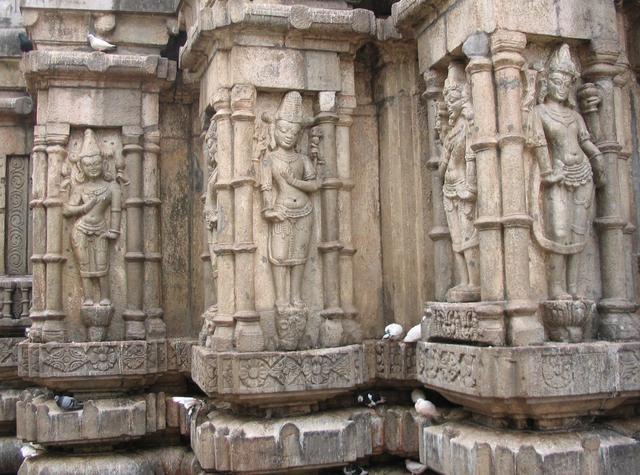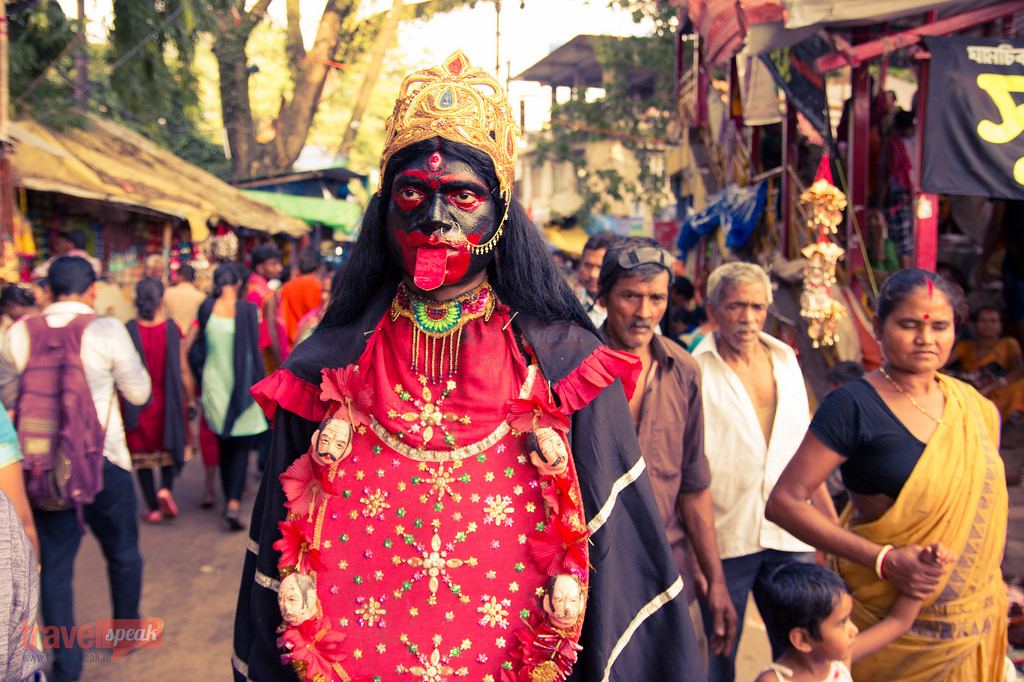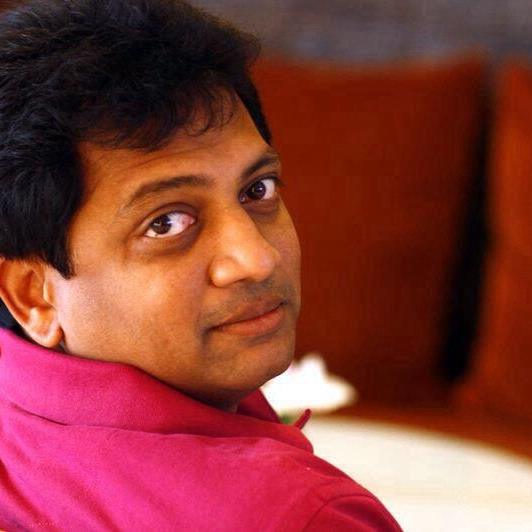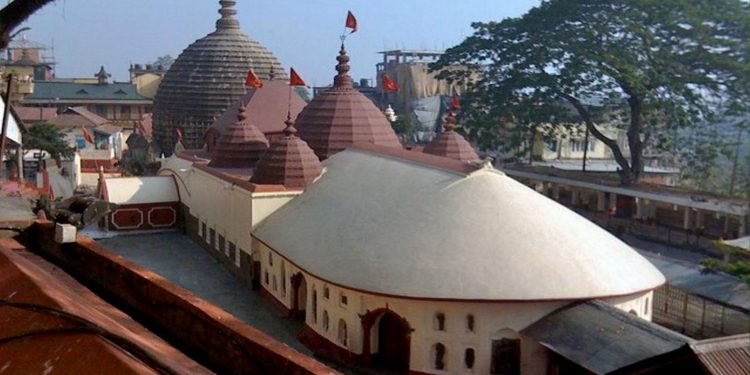Kamakhya Temple located on the Nilachal Hill in western part of Guwahati city in Assam, is one of the most important Shakti shrines in India
Shrine’s History
The present temple was constructed in 1565 by Chilarai of the Koch dynasty in the style of medieval temples. The form of the earlier structure, destroyed by the Kala Pahar, is unknown. The current structure has a beehive-like shikhara with delightful sculptured panels and images of Ganesha and other Hindu gods and goddesses on the outside.The temple consists of three major chambers.
The western chamber is large and rectangular and is not used by the general pilgrims for worship. The middle chamber is a square, with a small idol of the Goddess, a later addition. The walls of this chamber contain sculpted images of Naranarayana, related inscriptions and other gods.The middle chamber leads to the sanctum sanctorum of the temple in the form of a cave, which consists of no image but a natural underground spring that flows through a yoni-shaped cleft in the bedrock. It is also likely that this is an ancient Khasi sacrificial site, and worshiping here still includes sacrifices.
Devotees come every morning with goats to offer to Shakthi. Historical evidence indicates that between the 11th and 12th centuries, when there were repeated looting expeditions from Bihar and Bengal into Assam, the temples of the Nilachal Hills, including the Kamakhya Temple, were damaged and looted by Nasiruddin (1227) and Malik Uzbek Tughril Khan (1225 and 1257). During these looting expeditions the temple complex was likely severely damaged. Locals say that Koch Bihar royal family was banned by Devi herself from offering puja at the temple. In fear of this curse, to this day no descendants of that family dares to even look upward towards the Kamakhya hill while passing by. Without the support of the Koch royal family the temple faced lot of hardship. By the end of 1658, the Ahoms under king Jayadhvaj Singha had conquered the Lower Assam and their interests in the temple grew.
In the decades that followed the Ahom kings, all who were either devout Shaivite or Shakta continued to support the temple by rebuilding and renovating it. Rudra Singha (reign 1696 to 1714) was a devout Hindu and as he grew older he decided to formally embrace the religion and become an orthodox Hindu by being initiated or taking sharan of a Guru, who would teach him the mantras and become his spiritual guide. But, he could not bear the thought of humbling himself in front a Brahmin who is his subject. He therefore sent envoys to Bengal and summoned Krishnaram Bhattacharyya, a famous mahant of Shakta sect who lived in Malipota, near Santipur in Nadia district. The mahant was unwilling to come, but consented on being promised to be given the care of the Kamakhya temple to him. Though the king did not take sharan, he satisfied the mahant by ordering his sons and the Brahmins in his entourage to accept him as their spiritual guru. When Rudra Singha died, his eldest son Siba Singha (1714-1744), who became the king, gave the management of the Kamakhya temple and along with it large areas of land (Debottar land) to Mahant Krishnaram Bhattacharyya. The Mahant and his successors came to be known as Parbatiya Gosains, as they resided on top of the Nilachal hill. Many Kamakhya priests and modern Saktas of Assam are either disciples or descendants of the Parbatiya Gosains, or of the Nati and Na Gosains.
The Kamakhya Temple in Assam symbolizes the “fusion of faiths and practices” of Aryan and non-Aryan elements in Assam. The different names associated with the goddess are names of local Aryan and non-Aryan goddesses.The Yogini Tantra mentions that the religion of the Yogini Pitha is of Kirata origin. According to Banikanta Kakati, there existed a tradition among the priests established by Naranarayana that the Garos, a matrilineal people, offered worship at the Kamakhya site by sacrificing pigs.
The goddess is worshiped according to both the Vamachara (Left-Hand Path) as well as the Dakshinachara (Right-Hand Path) modes of worship. Offerings to the goddess are usually flowers, but might include animal sacrifices. In general female animals are exempt from sacrifice, a rule that is relaxed during mass sacrifices. The greatest shrine of tantric Shaktism find mention in the inscription of the Allahabad pillar of Samudragupta.

Legends Associated with This Shrine
As per Kalika Purana, Kamakhya Temple denotes the spot where Sati used to retire in secret to satisfy her amour with Shiva, and it was also the place where her yoni fell after Shiva danced with the corpse of Sati.This is not corroborated in the Devi Bhagavata, which lists 108 places associated with Sati’s body, though Kamakhya finds a mention in a supplementary list.The Yogini Tantra, a latter work, ignores the origin of Kamakhya given in Kalika Purana and associates Kamakhya with the goddess Kali and emphasises the creative symbolism of the yoni.
Once when Parvati’s father King Daksha organised a yagna, he did not invite his daughter and son-in-law to participate in it. Parvati, who was angry at this treatment of her father, went to her father’s place to ask the reason for it. Daksha insulted Parvati again by calling Shiva poor wild wanderer. Being the ideal consort of Shiva, Parvati could not bear the fact that her husband was being insulted in front of the guests. She immediately jumped into the yagna fire out of shame and anger and killed herself. Knowing this, Lord Shiva, became very angry and came to Daksha’s palace.
On seeing the dead body of his wife, he was so enraged that, he lifted the body on his shoulder and started dancing the tandav. The dance continued for several days and the earth was on the brink of being destroyed. Then, on the appeal of all the other gods and goddesses, Lord Vishnu with the help of his chakra, started cutting Goddess Parvati’s body. It is said that the parts of Parvati’s body fell at different parts of the country, which are all considered centers of power or Shakti peeth. The reproductive organ of Goddess Parvati is said to have fallen atop the Neelachal hill in Guwahati and that is where the Kamakhya temple stands now. Another story says that the demon Narakasura fell in love with Goddess Kamakhya once and he wanted to marry her. But as a goddess cannot marry a demon or asura,
Goddess Kamakhya played a trick to save herself. She laid a condition that she would marry him only if he builds a temple for her within one night. Narakasura agreed to it and almost finished building the temple overnight. This scared Goddess Kamakhya and before the final steps of the temple were completed, a cock was sent to cry cock-a-doodle-do to announce the arrival of the morning, before it was actually dawn.
This made Narakasura very angry and he killed the cock on that spot. But according to the condition Narakasura couldn’t marry Goddess Kamakhya after that. It is said that the present Kamakhya temple is the same that Narakasura had made for the Goddess. Another legendary source says that the supreme creative power of Bhrahma was challenged by Shakti, the mother Goddess, and that Bhrahma could thereafter create, only with the blessings of the Yoni, as the sole creative principle. After much penance, Bhrahma brought down a luminous body of light from heaven and placed it within the Yoni circle, which was created by the Goddess and placed at Kamarupa Kamakhya in Guwahati.

Architectural Relevance of This Shrine
The garbhagriha has a pancharatha planthat rests on plinth mouldings that are similar to the Surya Temple at Tezpur. On top of the plinths are dados from a later period which are of the Khajuraho or the Central Indian type, consisting of sunken panels alternating with pilasters. The panels have delightful sculptured Ganesha and other Hindu gods and goddesses. Though the lower portion is of stone, the shikhara in the shape of a polygonal beehive-like dome is made of brick, which is characteristic of temples in Kamrup. The shikhara is circled by a number of minaret inspired angashikharas of Bengal type charchala. The Shikhara, angashikharas and other chambers were built in the 16th century and after. The inner sanctum, the garbhagriha, is below ground level and consists of no image but a rock fissure in the shape of a yoni: The garbhagriha is small, dark and reached by narrow steep stone steps. Inside the cave there is a sheet of stone that slopes downwards from both sides meeting in a yoni-like depression some 10 inches deep. This hollow is constantly filled with water from an underground perennial spring. It is the vulva-shaped depression that is worshiped as the goddess Kamakhya herself and considered as most important pitha (abode) of the Devi. The garbhaghrihas of the other temples in the Kamakhya complex follow the same structure?a yoni-shaped stone, filled with water and below ground level.
Shrine’s Map Location and How to Go There
By Road
Guwahati has well-defined roads connecting it to all the parts of the state and the country.
By Rail
Guwahati has it own railway station. It is well-connected to all the parts of the country.
By Air
Guwahati has it own airport. Hence, reaching Kamakhya Temple by air is not a problem.
Shrine Timings
5:30 am – Snana of the Pithasthana 6:00 am – Nitya Puja 8:00 am – Temple doors open for devotees 1:00 pm – Temple doors closed for cooked offerings to the Goddess followed by distribution among the devotees. 2:30 pm – Temple door reopens for the devotees. 5:30 pm – Aarti of Goddess followed by closing of the temple door for the night
Events Celebrated at This Shrine
Being the centre for Tantra worship this temple attracts thousands of tantra devotees in an annual festival known as the Ambubachi Mela.During the Ambuvaci festival each summer,the menstruation of the Goddess Kamakhya is celebrated. During this time, the water in the main shrine runs red with iron oxide resembling menstrual fluid. At the time of Ambubachi mela, Kamakhya temple remains closed for three days and on the fourth day, the door is opened and a number of rituals are performed. Thousands of devotees and tourists line up at the temple, on this day every year, to observe the unique phenomenon and get the blessings of the Goddess. Besides this, a number of other pujas are held in the temple all round the year.These pujas include Durga Puja during navratris, Durgadeul, Madandeul, Manasa Puja, Pohan Biya and Vasanti Puja. Offerings are mainly in the form of flowers and fruits, but may include animal sacrifices as well.














































